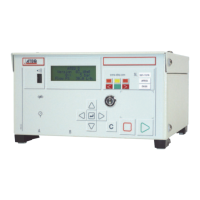Preamble
UM-22100H-U User manual ATEQ D520 Page 9/122
4. PRESSURE, TEMPERATURE & VISCOSITY EFFECT ON THE MEASUREMENT
4.1. PRESSURE VARIATION
As shown in the direct measurement diagram, the test part is in series in the test circuit,
the test pressure set by the regulator is not entirely restored at the input of the test part
due to pressure losses caused by the calibrated flow tube. Additionally the output
pressure of the regulator changes depending on the flows.
The results are always expressed as a function of the test pressure. That is why a
silicium sensor constantly monitors the real test pressure applied to the part. Depending
on the pressure value read the
ATEQ D520 applies a correction factor which allows a
constant compensation for the pressure drops in the test circuit.
Note that the further the test part is from the cell, the higher the pressure drop is. This
should be avoided (possibility of pressure measurement on the part).
4.2. VISCOSITY AND TEMPERATURE VARIATION
The viscosity of a gas is directly linked to its temperature. The higher the temperature is,
the greater the viscosity. The law of “Poiseuille” shows that when the viscosity
increases, the pressure drop increases.
These two parameters, temperature and viscosity have an influence on the accuracy of
the measurement. A correction is applied depending on the real temperature of the gas
flowing through the system.
Variations in the temperature of the parts during the test and in relation to each other
should be avoided by the "High precision" mode (optional):
An automatic acquisition cycle on a known master value is realised before each test
cycle, it allows calculating the test part value with the current atmospherics conditions.

